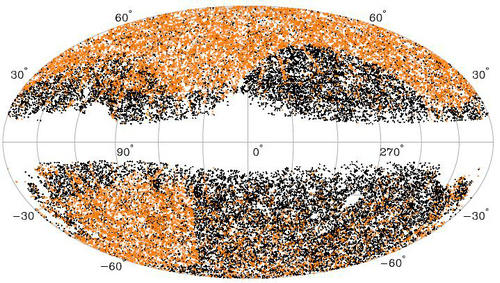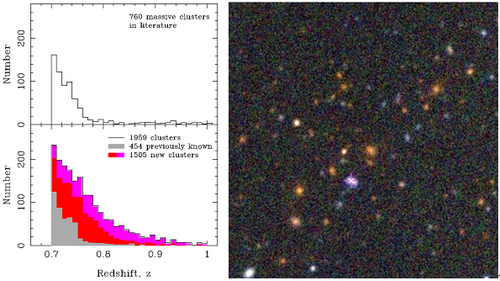
Clusters of galaxies are the largest gravitationally bound systems in the Universe, which consist of hundreds to thousands of galaxies, embedded in diffuse hot gas and dark matter. Finding more galaxy clusters is fundamental to many related researches.
By combining optical and infrared data, Dr. WEN Zhonglue and Prof. HAN Jinlin from the National Astronomical Observatories of the Chinese Academy of Sciences (NAOC) recently found more than 26,000 new nearby clusters and 1500 massive clusters in the distant Universe, which was a significant supplement to previous cluster catalogs.
Outside the Sloan Digital Sky Survey (SDSS) region, only a few thousand clusters were previously identified. In 2017, Dr. WEN and Prof. HAN found 47,600 nearby clusters of galaxies in the 28,000 square degree area of the sky (about two thirds of the whole sky) from public data of the Two Micron All Sky Survey, Wide-field Infrared Survey Explorer (WISE), and SuperCOSMOS. Among them, 26,125 clusters were recognized for the first time (Fig. 1).
In this study, by combining the data of SDSS and WISE, Dr. WEN and Prof. HAN identified 1959 massive distant clusters in the redshift range of 0.7<z<1, among which 1505 clusters were identified for the first time (Fig. 2). At redshifts z>0.75, the number of new clusters is 955, which is more than three times of previous known massive clusters.
Dr. WEN started the project on searching clusters during his PhD program, supervised by Prof. HAN. In 2009, they identified nearly 40,000 clusters from the sixth data release of SDSS. This was nearly three times larger than the previous largest sample.
Three years later in 2012, they identified 132,684 clusters from the eighth data release of SDSS covering 14,000 square degrees (about one third of the whole sky) by using their updated algorithm.
Afterwards they updated the redshift, i.e., the distance information for these clusters, and supplemented another 25,419 clusters at higher redshifts, making their cluster catalog not only the largest but also important database for many related studies over the world.
These works were published in Monthly Notices of the Royal Astronomical Society. The project was supported by the the National Natural Science Foundation of China.

Fig. 1. Sky distribution of 47,600 nearby clusters in the Galactic coordinates (the data in the Galactic plane were removed). The orange '×' stands for 21475 previously known clusters and black '+' for 26 125 newly identified clusters. (Image by NAOC)

Fig. 2. Left: redshift distribution of 1959 clusters identified from SDSS-WISE data. Right: an example of newly identified massive at z=0.86. Most galaxies with yellow colors are probable member galaxies of this cluster. (Image by NAOC)

86-10-68597521 (day)
86-10-68597289 (night)

52 Sanlihe Rd., Xicheng District,
Beijing, China (100864)

